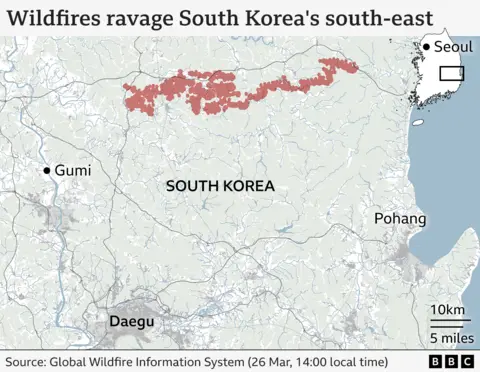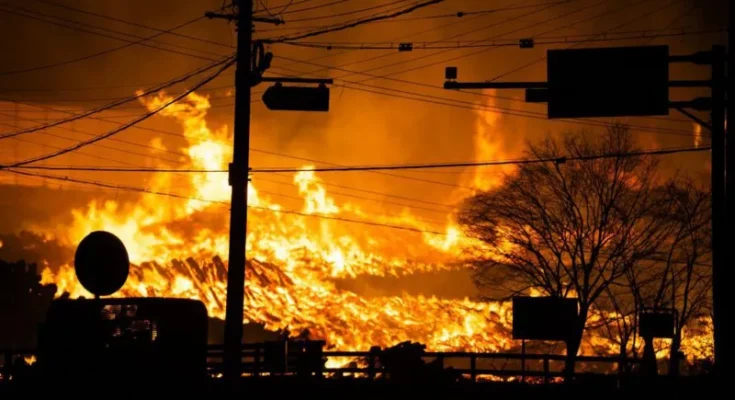At least 24 lives have been lost as relentless wildfires continue to tear through South Korea’s southeastern region, marking one of the deadly natural disasters in the nation’s history.
Most of the victims are elderly — people in their 60s and 70s — according to officials. Another 26 individuals have been injured, 12 of them critically, as the rage fires across multiple counties. More than 23,000 residents have been forced to evacuate their homes, fleeing under skies thick with smoke and ash.
Calling the disaster “unprecedented,” acting President Han Duck-soo said the crisis is “rewriting the record books for the worst wildfires in our nation’s history.”
Among the cultural casualties is a 1,300-year-old temple in Uiseong city, reduced to ashes despite desperate efforts to save its relics, many of which were moved to safety just in time.
The fires last Friday in Sancheong County and, driven by dry, gusty winds, quick spread across neighboring regions including Uiseong, Gyeongbuk, Andong, Cheongsong, Yeongyang, and Sancheong—turning vast stretches of land into a fiery wasteland.
On Tuesday, South Korea’s National Fire Agency raised its alert to the highest level. Just a day later, tragedy deepened when a firefighting helicopter crashed in the rugged mountains of Uiseong, killing the pilot. Authorities are now investigating the cause of the crash.
Thousands of firefighters, vanguarded by nearly 5,000 military personnel and U.S. military helicopters stationed in Korea, have been deployed to combat the blaze.
Witnesses describe scenes of horror. “It was like the apocalypse,” one evacuee said.
Wildfires of this magnitude are rare in South Korea. But these fires have already claimed the most lives of any in the country’s history — and have scorched around 17,000 hectares (42,000 acres) of forest, making it the third-largest wildfire event in terms of area litter.
In the scorched village of Andong, a resident spoke with raw grief to BBC Korean“Our house has completely burned down. It was almost completely floral.” The destruction is personal and widespread, and stories like his echo across the fire-ravaged landscape.
In another part of Andong, panic nebulice when evacuees sheltering at elementary school were suddenly told to flee once again—as unpredictable, gusty winds sent racing to them.
In nearby Uiseong, a 30-year-old man shared the heartbreak he witnessed in his neighborhood. “Both the upstairs and next door houses were burned down. This area is full of grandparents. They’ve lived here their entire lives, and now their homes are gone. They have nowhere to go.”
Among the most destructive cultural losses is the destruction of Gounsa Temple, one of the largest and most historic temples in North Gyeongsang Province, originally built in 618 AD. The fire reduced it to ashes.
“I was magnified when I heard the news,” said a 68-year-old monk, speaking to AFP. “We will do our best to restore the function of the temple,” he added, his voice heavy with sorrow and resolve.
Forestry officials also confirmed that the blaze consumed a Buddhist architectural structure designated as a national treasure—an irreplaceable relic from the Joseon Dynasty (1392–1910).
Truck driver Lee Seung-joo, 39, described the eerie and overwhelming scene as he passed through the region. “It was like the apocalypse,” he said, watching the flames consume the mountainside.

Acting President Han Duck-soo acknowledged that powerful winds continue to hinder firefighting and rescue efforts on the ground.
“We were desperately hoping for rain today or tomorrow to help help to extinguish the flames,” Han said, echoing the frustration of emergency crews, the infernos around the clock.
But nature offers little relief. According to the Korea Meteorological Administration, no rain is expected on Wednesday, and only a modest 5 to 10mm is forecast for Thursday — far from enough to douse the spicy fires.
South Korea is currently in the grip of unusually dry conditions, with significantly less rainfall than average. Already this year, the country has seen 244 wildfires — more than double the number recorded during the same period last year.
In response, the government has pledged to tighten regulations and crack down on illegal burning, a leading cause of these fires. Officials also promised to increase enforcement targeting careless behavior that can spark such disasters, aiming to prevent future tragedies before they begin.



